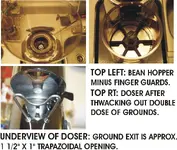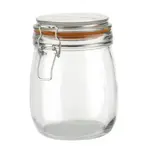If we're honest....most of us out there never clean our grinders

As for storing coffee in the refrigerator (a la alsterling), I would
not recommend it. Too much moisture! Remember, the three biggest enemies of coffee: (1) water; (2) oxygen; and (3) light. Basically, you need to put your beans in a tomb!
I appreciate your input, and would like to restate some very important points, and clarify some things..........
Yes, moisture would ruin the coffee. But this is about storage temperatures; both refrigeration and freezer. We can agree that moisture has to be taken out of the equation up front. In all storage, it's a given that the container must be reasonably air tight. My plastic jars are not "certified air-tight"... and that's not critical for the fridge, but more important for the freezer. I worry less about "light" as most storage locations are closed areas. Obviously, light as UV energy will cause oxidation damage, and light which translates to heat energy is, well, obviously not wanted. I sometimes will put small lot coffees, still in their retail bags, into containers and then into the fridge. But the point being that the coffee is closed off from atmosphere..... more or less. You don't need to obsess with wax seals, etc.

Everything goes into a plastic screw-top container, gets marked with source, product ID and date received/roasted. And yes, my default storage is the fridge. This wasn't a preference but the objective result of testing storage methods; cool dry cabinet, fridge and freezer, vacuum or reasonable air-tight containers.
I didn't theorize this...... I started doing storage tests 6 years ago with Malabar Gold, and counseled with Dr. John of Josuma Coffee when I was buying 10 pound sacks of this/his trademarked blend. Joseph is a Phd physicist. We've discussed storage many times, and he's agreed that storing his roasted product in a freezer works, if packed and placed immediately after receipt. If you're the roaster of your own product, as quickly as the roast cools. I've also done this over the years with coffees other than Malabar Gold, both using vacuum sealing and not. And the reason for recommending plastic in the fridge over glass is for obvious "drop and break" issues. I've only used vacuum packing with plastics in the freezer.
Vacuum packing seems to have no positive, or negative effect. And this entire discussion is, of course, for "small lot storage", (for home roasters... 250 gram/half pound roasts, typically), and certainly not necessary for retail operations where "cool and dry" is sufficient when you're working through inventory within one to two weeks after shipping/outgassing. Shipping times from the roaster of 2-4 days sometimes allows for sufficient outgassing while in transit, and can include another couple days of inventory control and shelving, where desired flavors can continue to develop. As an example, a retailer orders on Monday, it ships on Tuesday, received on Thursday or Friday, and ready to start using that weekend to Monday. When you go through your inventory in a week or less, common sense storage is just that; cool and dry.
When I got into specialty coffee I obsessed over alot of issues, primarily because I have a technical background, but also because I just didn't have any experience working with coffee. After handling it, like many of you, for years, I just know results from experience. And my most basic instinct with roasted beans or grounds is to store them in the fridge, in a resaonably decent closed container; it's just that simple.
And if you're a roaster, commercial or home, there have been some very interesting articles in Roast Magazine regarding "new tech" versus tradition green bean storage. Much of the discussion I remember in the articles was inconclusive, regarding some new materials versus traditional burlap sacks, etc. I've seen storage threads in forums for as long as I've been in this industry, and trust those who have actually approached it objectively and from a hands-on, practical application basis. No need to theorize...... just do your own tests and see if your methods of storage make any difference once the product hits your taste buds? And remember.... the chain is only as strong as the weakest link. Doing your testing with crap beans to begin with, or not brewing properly, pretty much negates the results. Just sayin' is all, Al
BTW..... I use a 1" foam brush to clear the chute on my Macap stepless doser. I grind 18 grams at a time, and don't use the doser for storage. This is a test bar, not a retail facility. So there's not enough constant action to keep the hopper filled, run the grinder timer for each porta-filter load, and disregard what's left in the chute. Like Randy G., I pulled all of the guards out of the doser to get easier access to the chute. A 1" brush is exactly the same width as the chute opening.




